9+ Sample Job Estimate
-
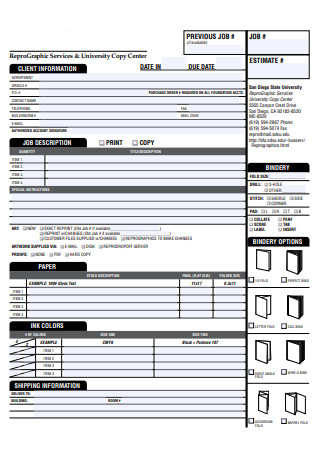
Job Estimate Template
download now -
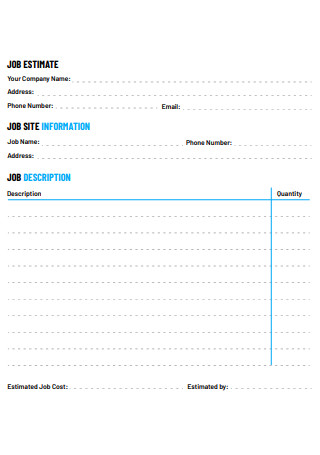
Simple Job Estimate
download now -
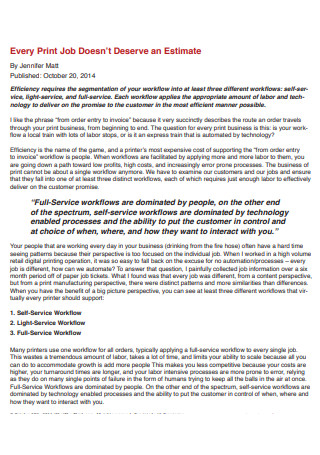
Printable Job Estimate
download now -
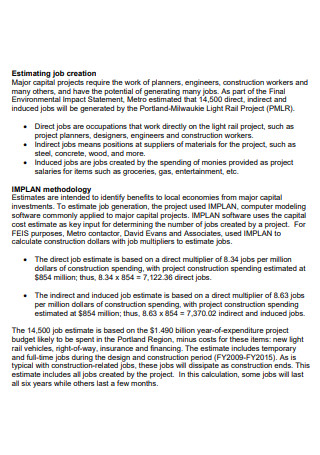
Job Estimating in PDF
download now -
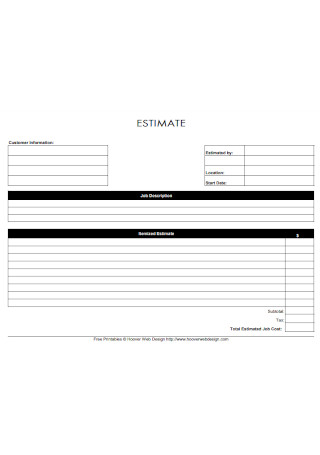
Job Description Estimate
download now -
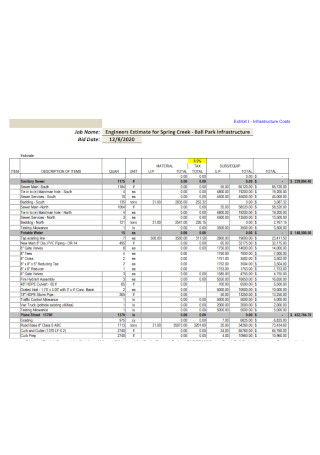
Engineers Job Estimate
download now -
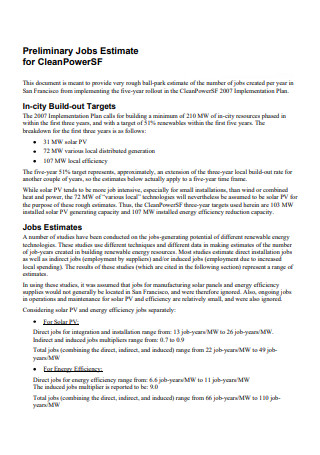
Preliminary Job Estimate
download now -
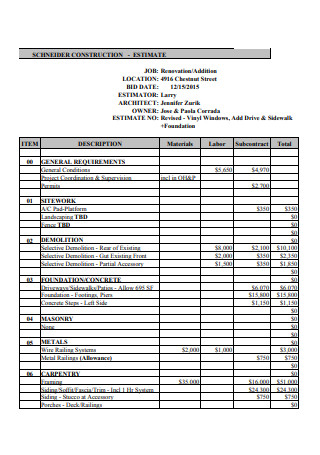
Construction Job Estimate
download now -
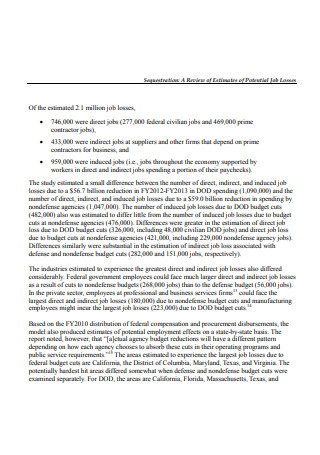
Potential Job Losses Estimate
download now -
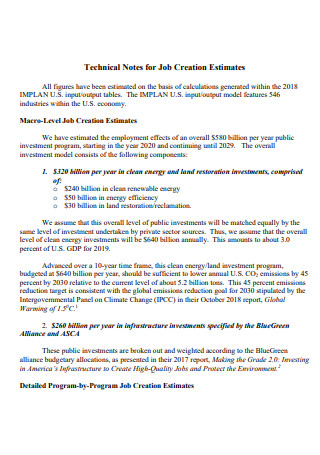
Technical Notes for Job Creation Estimate
download now
What is a Job Estimate?
A job estimate is a document utilized by workers and businesses to indicate a project scope of work and how much its estimated costs will be as a guide for a client. It is a detailed document that covers the type of service offered, how much it will cost, and the timeline in which the job will be completed. It is intended to show the client the project’s scope of work and what to expect once they are contracted. If the client’s expectations are met, project executors can begin the project process. And below, we further discuss how to write an estimate for a job.
What Are The Contents of a Job Estimate?
A job estimate is intended for a client to be aware of the expenses they will allocate their money to, what to expect and what not to expect in a project they hired someone for. The contractor should write an estimate detailed enough to give a client has a clear understanding of the project.
Benefits of a Job Estimate
Creating a job estimate lets you know the scope of work beforehand and helps you avoid doing more than the agreed terms; but depending on your brand and the services you provide, it’s never bad to go beyond what is expected of you if it is within your means. Doing more than the project’s scope of work is also costly for the contractor.
How To Calculate Job Costing
Job costing or project-based accounting, as it is called, is an accounting tool that allows workers and businesses to track how much a project will cost and the revenue it will gain. A job cost is calculated by combining the cost of labor, materials to be used, and extra expenses or overhead costs. This process is commonly used in the construction industry but also in a variety of jobs that offer products and services to complete a client’s project such as
- Manufacturing
- Hospitals and doctor’s offices
- Law firms
- Creative industries such as marketing firms and film studios
- Engineering firms
- Accounting companies
- Food processing businesses
Written as an equation, job costing is calculated like this:
Total Job Cost = Direct Materials + Direct Labor + Applied Overhead
Calculate Labor Costs
Labor cost is one of the most crucial—as it is costly—factors of a job contract. These are the total expenses that employers or clients allocate for their employees or contractors. They are funds allocated per day for the manpower aspect of a certain project. As a working professional, you may price your fees according to your experience level. Labor costs include salary and benefits, medical insurance, job training, accommodations, uniforms, and additional allowance such as that for food and travel that the employer may provide. Multiply the payroll date by the estimated amount of time it would take to complete the job.
Calculate Material Costs
These are the expenses that will be allocated for the commodities to be used in the project. There are two types of material costs which are direct and indirect material costs. Direct materials are the raw materials used in the process of creating of a project. The direct material cost depends on the finished product. Indirect materials are those essential for the production process but will not be directly used as an integral part of the product. You may choose to add a margin for the handling of materials costs such as for manpower and delivery fees.
Estimate Applied Overhead
Overhead or the indirect costs that cover a project are one of the most difficult to calculate—it needs to be estimated and has no fixed amount. These are neither labor nor material costs but all the extra expenses that are relayed to manpower and materials not directly associated with the finished product. Examples of overhead expenses are the expenses allotted for the facility such as power, insurance, office rent, supplies, and behind-the-scenes workers such as equipment maintenance, inspection and administrative costs. Most businesses already have a blanket overhead fee for each project.
FAQs
What is the difference between a job estimate and a quote?
A job estimate is not legally binding as it only provides the approximate cost for a job or project as opposed to a quote–which provides the clients with a fixed cost. A quote is intended to be valid for a certain time frame and once it is approved by the customer, it can’t be revised.
What is a project estimator?
Construction builders and manufacturing companies seek the help of Project Estimators, also known as Cost Estimators or Construction Cost Estimator when it comes to construction, to determine how much their project will cost. It is important to know how much a project will cost during the planning stages before a project begins. The cost of projects can fluctuate due to the condition of the raw materials or an additional need for resources such as manpower. This becomes costly for the client, and part of their job scope is to review work estimate bids offered by subcontractors to helps them cut costs by suggesting alternative solutions and providing them with a rough estimate to keep them within the budget. A Building Estimator is a type of Construction Estimator that estimates how much it would cost to build buildings.
What is an invoice?
An invoice is a bill you provide for your services. Once a client inquires about your services, you provide them with a job estimate. When they hire you and approve the details on the job estimate, you can send them an invoice.
How To Write A Job Estimate
The job estimate template will be the first document drafted before executing a client’s project. The detailed scope of work of your services will determine whether a client is appeased and will avail of your services. With proper planning and being on the same page with the client beforehand, a project can progress with a good start.
1.) Hands-on Approach With Your Client
Work closely with the client to go over the project’s scope and to gain a clear picture of their needs to ensure that you are on the same page during the initial step of planning the project. Meet with the client and take detailed notes on their ideal plan for the project to be able to execute the appropriate results. Get clarification on any questions pertaining to the project that you may have. And on the other hand, if the client has their own concerns, address them with the expertise that you have on the project’s scope. Most clients are unaware of the specifics that come with the systematized process it takes to get a job done, but they are aware of the expected outcome that they want. As a professional, you can give them suggestions for further project improvement. If they want specifics, it’s important to include them in the work estimate.
Do you want to see an itemized breakdown of services?
What services do you require? What services do you not require?
When is your expected project completion date?
2.) Estimate the Project Timeline
As the person who will be doing all of the work, devising a timeline beforehand would be beneficial to you to get an average timespan of how long you will spend on the project or how many hours it will cost you. This helps to determine how much to price your services. A client also needs an estimated date on the project’s timeline. Including a rough estimate of the date in writing avoids disputes later on. Any factors for the delay of the project such as other jobs you’ve been hired for should also be mentioned.
3.) Delegate Resources
After you get a complete overview of the project scope of work, be realistic in determining if you’re going to need extra help to complete the job. Big jobs or jobs with a wide scope may require the aid of subcontractors to help you meet the deadline based on the client’s expectations. Whether you are a one-man business, have other projects on your hands, or if the project scope is just too broad, it’s practical to delegating resources by getting an extra set of hands.
4.) Estimate Material Costs
After getting the job’s scope of work, you will need to determine the materials you will utilize to complete the project.
5.) Price Your Services Accordingly
As a professional that provides products and services of quality, it’s fair to earn what you are worth. Working professionals—inexperienced or experienced—provide services in order to cover the costs for their needs and daily living. They should get a just compensation for the services that they provide. Present your products and services with a price that aligns with the time and dedication it took to gain experience in your expertise, your professional hourly rate, and the materials needed to complete the project. A client who expects a project of good quality won’t mind paying for what it’s worth.
As an independent contractor or service provider, you will need to provide a detailed scope of work to your client who will benefit from your services. This job estimate covers the work that you will do and on the other hand—not do, the cost of your services, and what schedule you will adhere to until completion. This provides clients what to expect from the services they will commission you to do and how it fits within their budget as they have a rough estimate of the cost.
